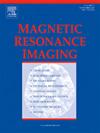Comparing single-shot EPI and 2D-navigated, multi-shot EPI diffusion tensor imaging acquisitions in the lumbar spinal cord at 3T
IF 2
4区 医学
Q2 RADIOLOGY, NUCLEAR MEDICINE & MEDICAL IMAGING
引用次数: 0
Abstract
Diffusion tensor imaging (DTI) can provide insights into spinal cord microstructure in health and disease; however, its application has been largely limited to cervical spinal segments using single-shot echo-planar imaging (EPI) diffusion-weighted MRI acquisitions. In this work, we evaluate a multi-shot EPI diffusion-weighted acquisition with reduced field-of-view (FOV) and 2D-navigated motion correction applied in the lumbar spinal cord of healthy volunteers, and compare image quality, geometric distortions, and quantitative DTI indices to those obtained with conventional, single-shot EPI diffusion-weighted MRI in a distinct, age/sex-matched healthy cohort. At 3 Tesla, 25 and 27 healthy participants were imaged using the single-shot and multi-shot EPI readouts with diffusion weighting, respectively, with matching resolution and comparable scan time. Seven participants underwent both diffusion acquisitions and were included in both cohorts. DTI indices were compared between the multi-shot and single-shot cohorts. Image signal-to-noise ratio (SNR), contrast-to-noise ratio (CNR) between gray and white matter, geometric distortions, and within-subject bias between the acquisitions were also assessed. The lumbar spinal cord diffusion indices derived from both cohorts were comparable to those in previous studies using single-shot EPI, though within-subject analysis demonstrated a systematic bias between the acquisitions in gray and white matter DTI measures, indicating these acquisitions are not interchangeable within a study. The multi-shot quantitative DTI maps demonstrated a significant reduction in image artifacts (i.e., distortions and blurring) and higher SNR and CNR compared to single-shot images. Overall, the reduced FOV, 2D-navigated, motion-corrected multi-shot acquisition demonstrated improved DTI quality metrics compared to single-shot, supporting its application for the lumbar spinal cord region.
比较单次EPI和2d导航,多次EPI弥散张量成像在3T腰椎
弥散张量成像(DTI)可以深入了解健康和疾病的脊髓微观结构;然而,它的应用在很大程度上仅限于颈椎节段,通过单次回波平面成像(EPI)弥散加权MRI获取。在这项工作中,我们评估了在健康志愿者腰椎脊髓中应用的多次EPI弥散加权成像,减少了视场(FOV)和2d导航运动校正,并比较了图像质量、几何畸变和定量DTI指数,与传统的单次EPI弥散加权MRI在不同年龄/性别匹配的健康队列中获得的结果。在3特斯拉时,分别使用具有扩散加权的单次和多次EPI读数对25和27名健康参与者进行成像,具有匹配的分辨率和可比较的扫描时间。7名参与者接受了两种扩散获取,并被纳入两个队列。比较多药组和单药组的DTI指数。还评估了图像信噪比(SNR)、灰质和白质之间的对比噪声比(CNR)、几何畸变和采集之间的受试者内偏差。来自两个队列的腰椎脊髓弥散指数与先前使用单次EPI的研究相当,尽管受试者内部分析表明灰质和白质DTI测量的获取之间存在系统性偏差,表明这些获取在研究中不可互换。与单镜头图像相比,多镜头定量DTI地图显示图像伪影(即失真和模糊)显著减少,信噪比和CNR更高。总的来说,与单镜头相比,减少视场、2d导航、运动校正的多镜头采集显示出更高的DTI质量指标,支持其在腰椎脊髓区域的应用。
本文章由计算机程序翻译,如有差异,请以英文原文为准。
求助全文
约1分钟内获得全文
求助全文
来源期刊

Magnetic resonance imaging
医学-核医学
CiteScore
4.70
自引率
4.00%
发文量
194
审稿时长
83 days
期刊介绍:
Magnetic Resonance Imaging (MRI) is the first international multidisciplinary journal encompassing physical, life, and clinical science investigations as they relate to the development and use of magnetic resonance imaging. MRI is dedicated to both basic research, technological innovation and applications, providing a single forum for communication among radiologists, physicists, chemists, biochemists, biologists, engineers, internists, pathologists, physiologists, computer scientists, and mathematicians.
 求助内容:
求助内容: 应助结果提醒方式:
应助结果提醒方式:


